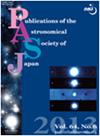New results on the two low-mass-ratio overcontact binaries V1309 Herculis and AS Coronae Borealis
IF 2.2
4区 物理与天体物理
Q2 ASTRONOMY & ASTROPHYSICS
引用次数: 0
Abstract
We present new multi-color light curves of V1309 Her and AS CrB, which were observed by the 60 cm telescope located at the Maidanak Astronomical Observatory. Combined with the Large-Sky-Area Multi-Object Fiber Spectroscopic Telescope atmospheric parameters, we analyzed our BVRCIC light curves for both systems by employing the Wilson–Devinney program. Our results show that both systems are low-mass-ratio overcontact binaries (V1309 Her: q = 0.213, AS CrB: q = 0.16). AS CrB has a high fill-out factor, while that of V1309 Her is moderate. By adding our new times of minimum light, we found the periodic oscillations in their O − C curves, which could be explained by the light travel-time effect of the third bodies. The third lights detected during the light curve analysis support the existence of the third bodies in V1309 Her and AS CrB. Third bodies usually play an important role for the origin and evolution of the central pair by removing their angular momentum. With the angular momentum loss, a moderate-fill-out overcontact binary like V1309 Her will evolve to a deep one like AS CrB. AS CrB lies at the late evolutionary stage of contact binaries. A long-term period increase at a rate of dP/dt = 5.22(± 0.28) × 10−7 d yr−1 was detected in our O − C diagram analysis. When its orbital angular momentum is less than three times the total spin angular momentum, a system may finally evolve into a rapid-rotating single star.两个低质量比过接触双星V1309 Herculis和AS Coronae Borealis的新结果
本文给出了由位于Maidanak天文台的60厘米望远镜观测到的V1309 Her和AS CrB的新的多色光曲线。结合大空域多目标光纤光谱望远镜大气参数,采用Wilson-Devinney程序分析了两个系统的BVRCIC光曲线。结果表明,这两个系统都是低质量比过接触双星(V1309 Her: q = 0.213, AS CrB: q = 0.16)。AS CrB填充系数高,而V1309 Her填充系数中等。通过添加新的最小光时间,我们发现它们的O−C曲线存在周期性振荡,这可以用第三体的光传播时间效应来解释。在光曲线分析中检测到的第三个光支持了V1309 Her和AS CrB中第三个天体的存在。第三体通过消除中心对的角动量,对中心对的起源和演化起着重要的作用。随着角动量的损失,像V1309 Her这样的中等填充过接触双星将演变成像AS CrB那样的深双星。AS - CrB处于接触双星演化的后期阶段。在我们的O - C图分析中检测到dP/dt = 5.22(±0.28)× 10−7 d yr−1的长期增长速率。当它的轨道角动量小于总自旋角动量的三倍时,一个系统可能最终演变成一个快速旋转的单星。
本文章由计算机程序翻译,如有差异,请以英文原文为准。
求助全文
约1分钟内获得全文
求助全文
来源期刊

Publications of the Astronomical Society of Japan
地学天文-天文与天体物理
CiteScore
4.10
自引率
13.00%
发文量
98
审稿时长
4-8 weeks
期刊介绍:
Publications of the Astronomical Society of Japan (PASJ) publishes the results of original research in all aspects of astronomy, astrophysics, and fields closely related to them.
 求助内容:
求助内容: 应助结果提醒方式:
应助结果提醒方式:


